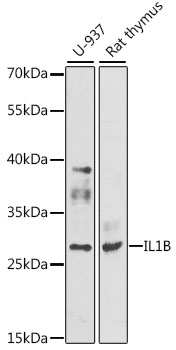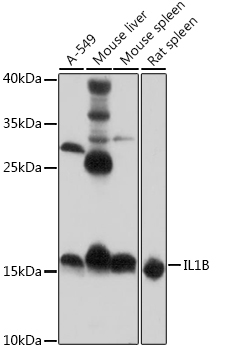

| WB | 咨询技术 | Human,Mouse,Rat |
| IF | 咨询技术 | Human,Mouse,Rat |
| IHC | 咨询技术 | Human,Mouse,Rat |
| ICC | 技术咨询 | Human,Mouse,Rat |
| FCM | 咨询技术 | Human,Mouse,Rat |
| Elisa | 咨询技术 | Human,Mouse,Rat |
| Aliases | IL1B; IL1F2; Interleukin-1 beta; IL-1 beta; Catabolin |
| Entrez GeneID | 3553 |
| WB Predicted band size | Calculated MW: 31 kDa; Observed MW: 31 kDa |
| Host/Isotype | Rabbit IgG |
| Antibody Type | Primary antibody |
| Storage | Store at 4°C short term. Aliquot and store at -20°C long term. Avoid freeze/thaw cycles. |
| Species Reactivity | Human,Mouse,Rat |
| Immunogen | Recombinant fusion protein containing a sequence corresponding to amino acids 124-223 of human IL1B (NP_000567.1).CTLRDSQQKSLVMSGPYELKALHLQGQDMEQQVVFSMSFVQGEESNDKIPVALGLKEKNLYLSCVLKDDKPTLQLESVDPKNYPKKKMEKRFVFNKIEIN |
| Formulation | Purified antibody in PBS with 0.05% sodium azide,0.5%BSA and 50% glycerol. |
+ +
以下是3-4条关于IL-1β抗体的代表性文献及其简要摘要:
---
1. **文献名称**: *Antiinflammatory Therapy with Canakinumab for Atherosclerotic Disease*
**作者**: Ridker PM et al.
**摘要**: 该研究(CANTOS试验)探讨了IL-1β单克隆抗体Canakinumab在心血管疾病中的应用。结果显示,Canakinumab显著降低炎症标志物(如hs-CRP),并减少心血管事件风险,验证了靶向IL-1β的抗炎治疗对动脉粥样硬化的潜在疗效。
---
2. **文献名称**: *Targeting interleukin-1 in inflammatory disease*
**作者**: Dinarello CA.
**摘要**: 这篇综述总结了IL-1β在炎症性疾病(如类风湿性关节炎、痛风)中的核心作用,并讨论了IL-1β抗体(如Canakinumab、Gevokizumab)的临床开发进展,强调其通过阻断IL-1信号通路缓解病理过程的机制。
---
3. **文献名称**: *Treatment of rheumatoid arthritis with recombinant human interleukin-1 receptor antagonist*
**作者**: Bresnihan B et al.
**摘要**: 研究评估了IL-1受体拮抗剂Anakinra(类似抗体作用)对类风湿性关节炎患者的疗效,发现其可显著改善关节症状和炎症指标,支持IL-1β通路抑制在自身免疫病中的治疗价值。
---
4. **文献名称**: *Sustained interleukin-1β overexpression exacerbates tau pathology despite reduced amyloid burden in an Alzheimer’s mouse model*
**作者**: Shaftel SS et al.
**摘要**: 该研究利用IL-1β中和抗体在小鼠模型中探讨神经炎症与阿尔茨海默病的关系,发现抑制IL-1β可减轻淀粉样斑块负担,但可能加剧tau蛋白病理,提示IL-1β靶向治疗在中枢神经系统疾病中的复杂作用。
---
以上文献涵盖IL-1β抗体在心血管、自身免疫及神经退行性疾病中的基础研究与临床应用。如需具体引用,请核对期刊名称、卷号及发表年份(例如CANTOS试验发表于*NEJM*, 2017)。
Interleukin-1 beta (IL-1β) is a pro-inflammatory cytokine critical in mediating immune responses, primarily produced by activated macrophages, monocytes, and dendritic cells. It plays a central role in host defense by regulating innate immunity, inflammation, and cellular differentiation. However, dysregulated IL-1β production is implicated in various inflammatory and autoimmune diseases, including rheumatoid arthritis, gout, and cryopyrin-associated periodic syndromes (CAPS), as well as neurodegenerative and metabolic disorders. IL-1β is synthesized as an inactive precursor (pro-IL-1β) that requires proteolytic cleavage by caspase-1. activated via the inflammasome complex (e.g., NLRP3), to become biologically active.
IL-1β-targeting antibodies are therapeutic or research tools designed to neutralize its activity. Monoclonal antibodies like canakinumab bind directly to IL-1β, preventing its interaction with the IL-1 receptor (IL-1R1) and blocking downstream signaling pathways (e.g., NF-κB, MAPK). Clinically, canakinumab is approved for CAPS and other autoinflammatory diseases, demonstrating efficacy in reducing inflammation and disease progression. Research-grade antibodies are widely used to study IL-1β expression, localization, and function in experimental models. Challenges include optimizing specificity to avoid interfering with related cytokines (e.g., IL-1α) and addressing variable patient responses. Ongoing studies explore IL-1β inhibition in broader contexts, such as atherosclerosis and cancer, highlighting its multifaceted role in pathophysiology.
×